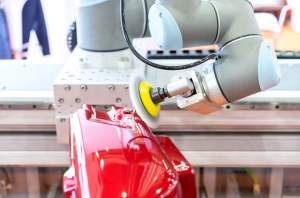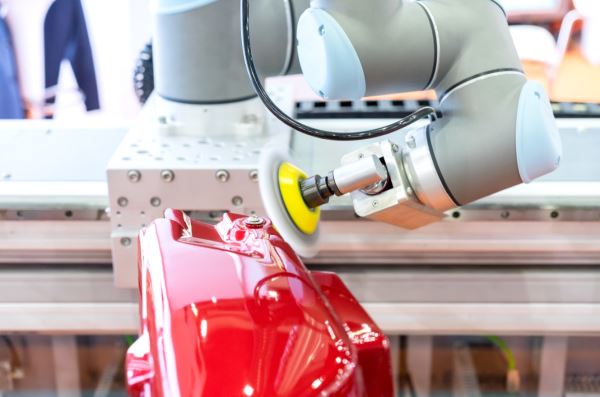Australia’s highly competitive car repair industry is big and getting bigger.
Motor vehicle ownership in Australia is at more than one vehicle for every two people, and vehicle servicing and repair is a key part of vehicle ownership.
According to latest IBIS figures, the $8 billion-plus car repair industry has an estimated 23,000 businesses across Australia and employs nearly 68,000 people.
After decades of relying on manual skills, the automotive repair industry is now undergoing a major transformation.
As competition grows and profits shrink, repairers are now turning to the latest automated solutions.
And one Australian company is leading the way.
Tradiebot Industries, a startup company with ground breaking new technologies, is spearheading an Industry 4.0 automotive revolution.
Tradiebot is developing technology platforms and automated systems that can fast track routine jobs, repairs, training, and deliver an up-skilled workforce.
Unique solutions
“We’re a small company with big ideas,” Tradiebot CEO and founder Mario Dimovski told Inside Robotics.
“I’ve been involved in the car repair industry for almost 28 years and I have a great understanding of how it all works.
“With key partners, Tradiebot has developed solutions that can benefit the entire industry.
“Our technology is way beyond anything else that’s out there at the moment,” he says proudly.
And this technology is set to change the auto repair industry as we know it.
Using robotics, automation and 3D printing technologies to streamline automotive plastic repairs and reduce costs, the company is fast attracting global attention.
Collaboration with leading universities
Tradiebot is now working on projects with universities and research bodies including Swinburne University of Technology, University of NSW and Deakin as well as the Advanced Manufacturing Growth Centre and Innovative Manufacturing Cooperative Research Centre (IMCRC).
It has also forged a strategic partnership with PPG Industries, one of the world’s biggest suppliers of paints, coatings and specialty materials.
Through PPG’s extensive network in more than 70 countries, Tradiebot aims to eventually offer its new technologies to the world.
“We want to first roll them out into the local market before exporting them internationally,” says Mr Dimovski.
Mr Dimovski says his collaborations with leading universities and research centres have been vital in the development of innovative solutions for the auto industry.
“We are currently working closely with universities on three different projects,” he says.
“Each project has been tailored for that particular uni. “We find out which universities are best suited to each project by looking at their strengths and expertise.”
World-first technology
Earlier this year, his company partnered with Swinburne and IMCRC to develop world-first technology that will revolutionise repairs of plastic components.
The collaborative project, Repair Bot, uses 3D printing technologies and robotics along with complex materials to enable an automated rapid repair service for plastic car parts.
Inspiration for the project stems from a need for technology-driven solutions to issues facing the automotive repair industry. These issues range from material wastage, complex and restrictive design elements and the limited availability of skilled labour.
“The ability to repair previously non-repairable parts using world-first technology will reduce overall repair times and repair costs,” Mr Dimovski explains.
“It will also create real and significant export opportunities and has flow-on benefits for the environment by reducing land-fill.
“Tradiebot will also deliver new future skills to the industry as more processes become automated.”
Robotics will play a key role
Mr Dimovski predicts robotics will play a huge role in the future of the auto repair industry.
“It’s at the core of our innovation.”
Robotic machines bring flexibility to a production system with the right combination of sensors, actuators and digital control logic to perform a variety of tasks.
With modern automation car repairers can increase precision, speed and accuracy allowing machines to perform repetitive tasks with zero defects and perfect consistency.
A robotic system can be connected to a global knowledge database to provide machine learning and control algorithms.
This kind of technology is set to revolutionise the car repair business and at the same time create a next generation workforce, Mr Dimovski says.
3D printed auto parts
Also, 3D printing used in conjunction with new polymer material solutions will enable a low-cost rapid repair service for automotive plastic trim and assembly components.
The goal is to have stronger, lighter and cheaper materials that can be 3D printed with the accuracy and performance of mainstream production parts.
Tradiebot is also using virtual and augmented reality (now well-known for its applications in the gaming) as a training tool.
“Industries are beginning to see the potential of using these virtual tools in staff training,” he says.
Virtual and augmented reality can help to reduce set up costs and staff logistics by creating a virtual work space for training purposes.
Embracing Industry 4.0
Mr Dimovski, a recognised expert in Industry 4.0, says more Australian industries are now embracing digital technology.
But unfortunately, when it comes to Industry 4.0, educators have “missed the boat,” he says.
In fields such as engineering and technology, the skills gap is widening.
“Where are we going to find those people?” Mr Dimovksi asks.
“While industry is rapidly developing new technologies, the education system is struggling to keep up.
“They don’t have sufficient courses in place to feed the demand.”
Mr Dimovski is a strong advocate for promoting STEM (science, technology, engineering and maths) skills in schools throughout Australia.
Robotics will help fill the skills gap
“Hopefully, we (Tradiebot) can play a part in encouraging more students to focus on STEM – and help make a difference.
“STEM skills have to start at school. “In five years’ time, just about every job will require some kind of coding.”
It has been estimated there are about 50 new skills emerging for people interested in STEM careers.
Mr Dimovski says robotics will help to fill the skills gap by upskilling Australia’s workforce.
“Labourers will become robotics technicians by default – we will need people to manage the robots.”
He’s not expecting any job losses in the automotive industry due to automation.
“We will be creating new roles giving technicians an opportunity to upskill.
“Staff will develop more skills as cobots develop and integrate into the industry process.”
Auto repairers that don’t embrace automation will not survive, Mr Dimovksi warns.
Relying on hand skills for too long
“Many of those businesses have been focussing on hand skills for too long – and clearly that’s no longer working.
“They need to re-invent their manufacturing processes. Those that don’t adapt will unfortunately fall behind.”
So where will Tradiebot be in five years time?
“We will definitely be a pioneer in the automotive repair space.
“It’s rapidly evolving and we are a fast follower as well as a pioneer.
“We are aligning ourselves with the right people … so I definitely think we will be a global player in the auto sector.”
And Mr Dimovski believes the potential benefits of his new technologies go far beyond the automotive collision industry.
“We are receiving a great deal of interest from areas outside the automotive sector like defence and other industries that are using automated vehicles.
“Basically, our technology can be applied to just about anything that has wheels.
“The future potential is great.”


